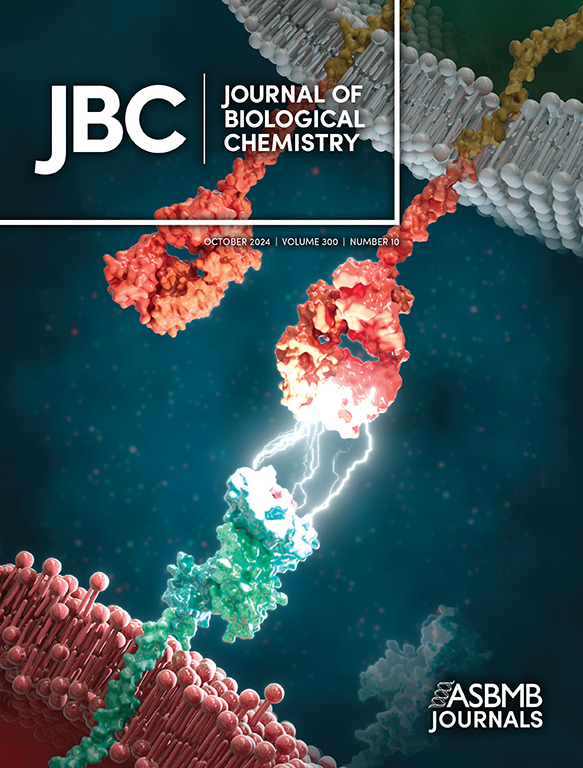具有高atp酶活性的细菌肌动蛋白调节对螺旋体游泳运动至关重要的伙伴MreB异构体的聚合。
IF 4
2区 生物学
Q2 BIOCHEMISTRY & MOLECULAR BIOLOGY
引用次数: 0
摘要
螺原体是一种无壁螺旋状细菌,其特点是具有独特的游泳运动,涉及细菌肌动蛋白MreBs (SMreB1-5)的五种亚型。smreb的功能在MreB家族蛋白中是独一无二的,因为它们在有壁细菌中的对应物通过形成细丝来定位细胞壁合成复合物,细丝缓慢地翻转以保持细胞形状。对单个smreb的体外分析为了解螺原体游动的详细分子机制提供了线索。然而,纯化的困难阻碍了对其中一种驱动游泳的smreb SMreB1的体外分析。本研究分离了鼠毛螺旋体可溶性SMreB1 (SpeMreB1),并对其活性进行了评价。SpeMreB1与可溶性标记蛋白(PrS)融合表达,这使我们能够在可溶性部分中纯化它。SpeMreB1表现出最高的磷酸盐(Pi)释放率和MreB家族蛋白中跨核苷酸态聚合临界浓度的倍数变化。SpeMreB1与聚合的SpeMreB5相互作用,SpeMreB5是螺原体游动必需的另一种SMreB。在AMPPNP-或adp结合状态下,SpeMreB1减少了SpeMreB5细丝的数量,这可能反映了它们的分解。无论核苷酸状态如何,SpeMreB1都与带负电荷的脂质结合。这些结果表明SpeMreB1利用其最高活性来管理细胞膜下的SpeMreB5细丝来驱动螺旋体游动。重要性:在大多数细菌物种中,MreB形成稳定的细丝,通过定位细菌细胞壁合成复合物参与细胞形状的维持。相比之下,致病无壁螺旋状细菌螺原体中的5种MreBs亚型参与其独特的运动系统,该运动系统由螺旋细胞的扭结繁殖驱动。我们的综合生化分析表明,参与甲壳类病原体S. eriocheiris游动的一种MreB亚型(SpeMreB1)在MreB家族蛋白中异常活跃,并管理游动必需的另一种MreB (SpeMreB5)的聚合。这项研究揭示了一个进化之谜,即螺旋体如何使静态MreB蛋白适应动态现象,如游泳运动。本文章由计算机程序翻译,如有差异,请以英文原文为准。
A bacterial actin with high ATPase activity regulates the polymerization of a partner MreB isoform essential for Spiroplasma swimming motility.
Spiroplasma is a wall-less helical bacterium that is characterized by a unique swimming motility involving five isoforms of the bacterial actin MreBs (SMreB1-5). The functions of SMreBs are unique in the MreB family proteins, as their counterparts in walled-bacteria localize the cell-wall synthesis complex by forming filaments that slowly turn over to maintain the cell shape. In vitro analyses of individual SMreBs provide clues to understand the detailed molecular mechanism of Spiroplasma swimming. However, the purification difficulties have hampered in vitro analyses of one of the SMreBs, SMreB1, which drives the swimming. Here, we isolated soluble SMreB1 of Spiroplasma eriocheiris (SpeMreB1) and evaluated its activity. SpeMreB1 was expressed as a fusion with a solubilization-tag, ProteinS (PrS), which allowed us to purify it in the soluble fraction. SpeMreB1 exhibited the highest phosphate (Pi) release rate and the fold changes of critical concentrations for polymerization across the nucleotide states among the MreB family proteins. SpeMreB1 interacted with polymerized SpeMreB5, another SMreB essential for Spiroplasma swimming. In the AMPPNP- or ADP-bound state, SpeMreB1 decreased the amount of SpeMreB5 filaments, possibly reflecting their disassembly. Regardless of the nucleotide state, SpeMreB1 bound to negatively charged lipids. These results suggest that SpeMreB1 utilizes its highest activity to manage SpeMreB5 filaments underneath the cell membrane to drive Spiroplasma swimming. IMPORTANCE: In most bacterial species, MreB forms stable filaments that are involved in cell-shape maintenance by localizing the bacterial cell-wall synthesis complex. In contrast, five isoforms of MreBs in the pathogenic wall-less helical bacterium Spiroplasma are involved in its unique motility system driven by a kink propagation along the helical cell. Our integrated biochemical assays show that one isoform of MreBs involved in the swimming of a crustacean pathogen S. eriocheiris (SpeMreB1) is exceptionally active in the MreB family proteins and manages the polymerization of another MreB essential for the swimming (SpeMreB5). This study sheds light on an evolutionary mystery how Spiroplasma has adapted static MreB proteins to a dynamic phenomenon like its swimming motility.
求助全文
通过发布文献求助,成功后即可免费获取论文全文。
去求助
来源期刊

Journal of Biological Chemistry
Biochemistry, Genetics and Molecular Biology-Biochemistry
自引率
4.20%
发文量
1233
期刊介绍:
The Journal of Biological Chemistry welcomes high-quality science that seeks to elucidate the molecular and cellular basis of biological processes. Papers published in JBC can therefore fall under the umbrellas of not only biological chemistry, chemical biology, or biochemistry, but also allied disciplines such as biophysics, systems biology, RNA biology, immunology, microbiology, neurobiology, epigenetics, computational biology, ’omics, and many more. The outcome of our focus on papers that contribute novel and important mechanistic insights, rather than on a particular topic area, is that JBC is truly a melting pot for scientists across disciplines. In addition, JBC welcomes papers that describe methods that will help scientists push their biochemical inquiries forward and resources that will be of use to the research community.
 求助内容:
求助内容: 应助结果提醒方式:
应助结果提醒方式:


